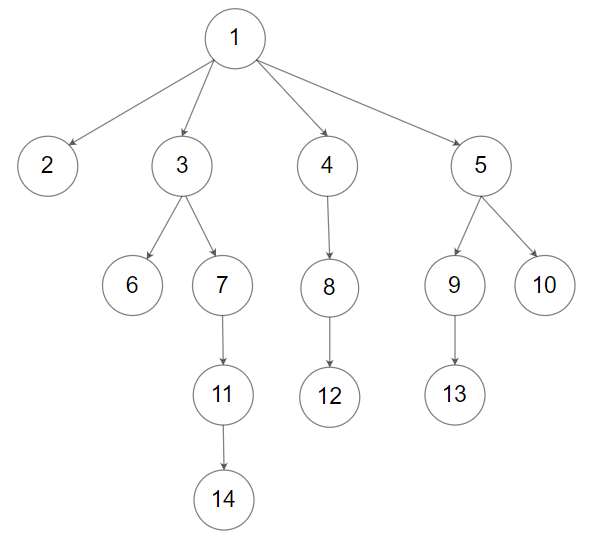[LeetCode] 559. Maximum Depth of N-ary Tree N叉树的最大深度
Given a n-ary tree, find its maximum depth.
The maximum depth is the number of nodes along the longest path from the root node down to the farthest leaf node.
Nary-Tree input serialization is represented in their level order traversal, each group of children is separated by the null value (See examples).
Example 1:

Input: root = [1,null,3,2,4,null,5,6] Output: 3
Example 2:

Input: root = [1,null,2,3,4,5,null,null,6,7,null,8,null,9,10,null,null,11,null,12,null,13,null,null,14] Output: 5
Constraints:
- The total number of nodes is in the range
[0, 104]. - The depth of the n-ary tree is less than or equal to
1000.
这道题让求一个N叉树的最大深度,由于之前做过 Maximum Depth of Binary Tree 那道题,所以有了求二叉树的基础后,求N叉树也就不难了,无非就是稍稍变换了一下吗,由固定的左右子结点变成了一个一堆子结点,但是方法还是没有变。首先来看一种常见的递归解法,就是需要有一个当前深度,然后带一个全局变量 res 进去。在递归函数中,如果 node 为空,直接返回。若子结点数组为空,那么结果 res 和 cur 比较取较大值。否则就遍历子结点数组,对每个子结点调用递归函数,这里的 cur 要自增1,参见代码如下:
解法一:
class Solution { public: int maxDepth(Node* root) { int res = 0; helper(root, 1, res); return res; } void helper(Node* node, int cur, int& res) { if (!node) return; if (node->children.empty()) res = max(res, cur); for (Node* child : node->children) { helper(child, cur + 1, res); } } };
我们也可以不使用其他的函数,直接主函数中递归,首先判空,否则就是遍历子结点数组,然后对每个子结点调用递归函数的返回值加1后跟 res 相比,取较大值更新结果res,参见代码如下:
解法二:
class Solution { public: int maxDepth(Node* root) { if (!root) return 0; int res = 1; for (Node* child : root->children) { res = max(res, maxDepth(child) + 1); } return res; } };
我们也可以不使用递归,而是用迭代的形式,这里借助队列 queue 来做,就是 BFS 的经典写法,不算难,参见代码如下:
解法三:
class Solution { public: int maxDepth(Node* root) { if (!root) return 0; int res = 0; queue<Node*> q{{root}}; while (!q.empty()) { for (int i = q.size(); i > 0; --i) { auto t = q.front(); q.pop(); for (auto child : t->children) { if (child) q.push(child); } } ++res; } return res; } };
Github 同步地址:
https://github.com/grandyang/leetcode/issues/559
类似题目:
参考资料:
https://leetcode.com/problems/maximum-depth-of-n-ary-tree/
https://leetcode.com/problems/maximum-depth-of-n-ary-tree/discuss/148544/Java-Top-down-DFS-solutions











【推荐】还在用 ECharts 开发大屏?试试这款永久免费的开源 BI 工具!
【推荐】国内首个AI IDE,深度理解中文开发场景,立即下载体验Trae
【推荐】编程新体验,更懂你的AI,立即体验豆包MarsCode编程助手
【推荐】轻量又高性能的 SSH 工具 IShell:AI 加持,快人一步
· .NET 原生驾驭 AI 新基建实战系列:向量数据库的应用与畅想
· 从问题排查到源码分析:ActiveMQ消费端频繁日志刷屏的秘密
· 一次Java后端服务间歇性响应慢的问题排查记录
· dotnet 源代码生成器分析器入门
· ASP.NET Core 模型验证消息的本地化新姿势
· 开发的设计和重构,为开发效率服务
· 从零开始开发一个 MCP Server!
· .NET 原生驾驭 AI 新基建实战系列(一):向量数据库的应用与畅想
· Ai满嘴顺口溜,想考研?浪费我几个小时
· ThreeJs-16智慧城市项目(重磅以及未来发展ai)
2017-10-29 [LeetCode] Minimum ASCII Delete Sum for Two Strings 两个字符串的最小ASCII删除和
2016-10-29 [LeetCode] All O`one Data Structure 全O(1)的数据结构
2015-10-29 [CareerCup] 13.1 Print Last K Lines 打印最后K行
2014-10-29 [LeetCode] 88. Merge Sorted Array 合并两个有序数组